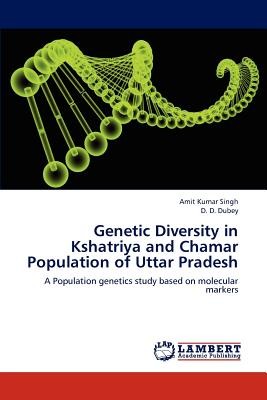
- We will send in 10–14 business days.
- Author: Amit Kumar Singh
- Publisher: LAP Lambert Academic Publishing
- ISBN-10: 3659197068
- ISBN-13: 9783659197062
- Format: 15.2 x 22.9 x 0.7 cm, softcover
- Language: English
- SAVE -10% with code: EXTRA
Genetic Diversity in Kshatriya and Chamar Population of Uttar Pradesh (e-book) (used book) | bookbook.eu
Reviews
Description
India is a country with rich cultural heritage showing striking diversities in terms of language, marriage practices as well as in their genetic architecture. Geneticists and anthropologists have attempted to elucidate the nature of India's rich diversity for decades. In this book, a study was carried out on the two populations, Kshatriya and Chamars of Uttar Pradesh, India to obtain their and inter and intra population variation in the genome using mitochondrial and Y chromosome markers. Mitochondria and Y chromosome are inherited through mother and father, respectively, have been used extensively in the study of modern human origins and other phylogenetic studies. In the zygote, genetic contribution of sperm differs from that of egg in two complementary ways: it fails to contribute mitochondria - these are, therefore, maternally inherited; and in half of fertilizations it alone contributes a Y chromosome. Being haploid neither of these segments of DNA recombines at meiosis, and so whatever the changes accumulated in the past can be traced back to mutational events occurred in the history of their respective DNAs. Thus they act as a repository of changes occurred in their past.
EXTRA 10 % discount with code: EXTRA
The promotion ends in 19d.17:58:18
The discount code is valid when purchasing from 10 €. Discounts do not stack.
- Author: Amit Kumar Singh
- Publisher: LAP Lambert Academic Publishing
- ISBN-10: 3659197068
- ISBN-13: 9783659197062
- Format: 15.2 x 22.9 x 0.7 cm, softcover
- Language: English English
India is a country with rich cultural heritage showing striking diversities in terms of language, marriage practices as well as in their genetic architecture. Geneticists and anthropologists have attempted to elucidate the nature of India's rich diversity for decades. In this book, a study was carried out on the two populations, Kshatriya and Chamars of Uttar Pradesh, India to obtain their and inter and intra population variation in the genome using mitochondrial and Y chromosome markers. Mitochondria and Y chromosome are inherited through mother and father, respectively, have been used extensively in the study of modern human origins and other phylogenetic studies. In the zygote, genetic contribution of sperm differs from that of egg in two complementary ways: it fails to contribute mitochondria - these are, therefore, maternally inherited; and in half of fertilizations it alone contributes a Y chromosome. Being haploid neither of these segments of DNA recombines at meiosis, and so whatever the changes accumulated in the past can be traced back to mutational events occurred in the history of their respective DNAs. Thus they act as a repository of changes occurred in their past.


Reviews